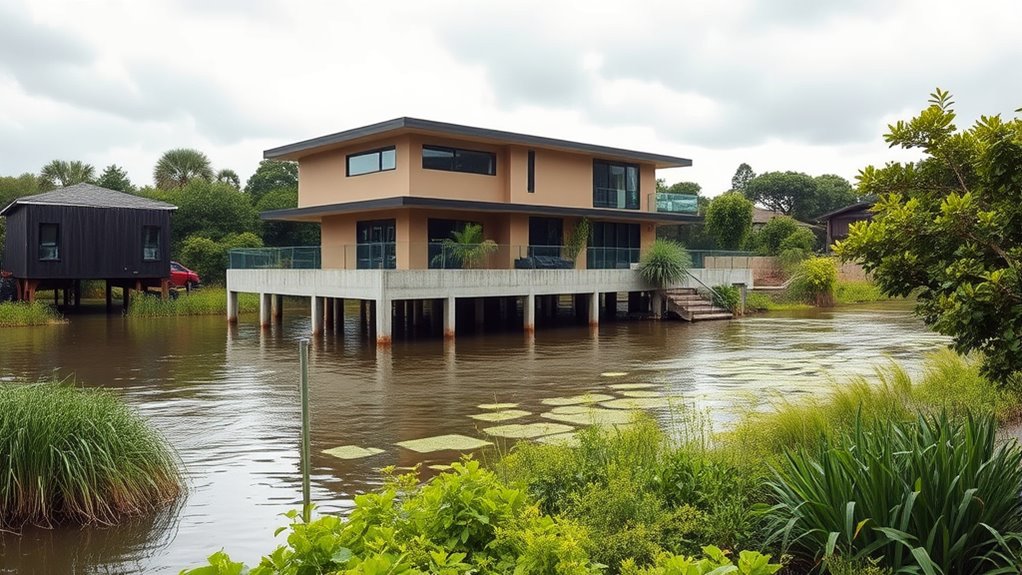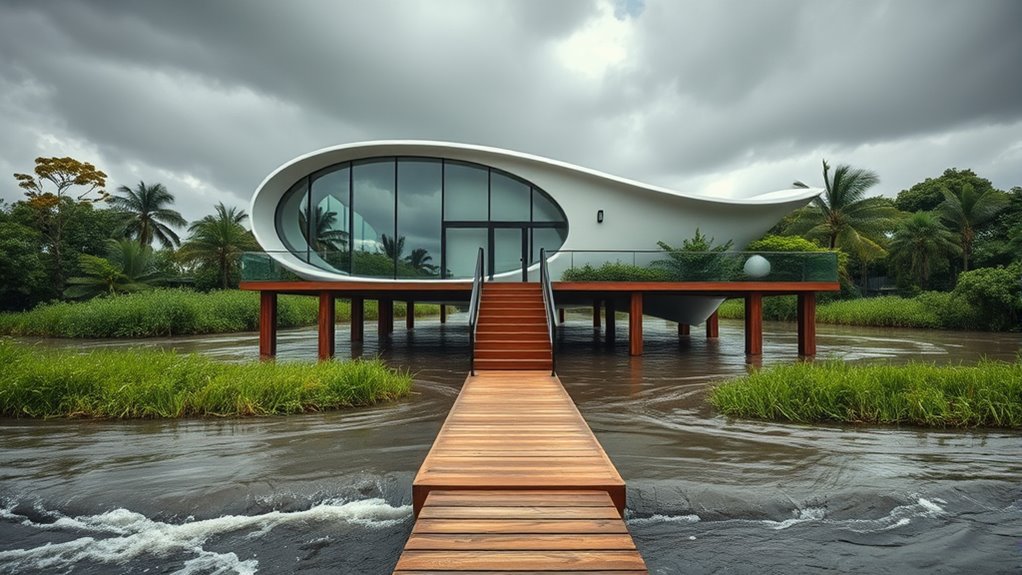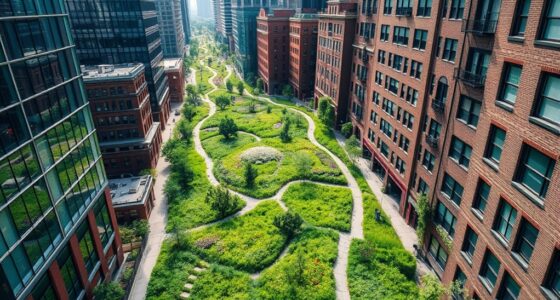To stay safe during floods, consider low-impact designs like green roofs, permeable pavements, and rain gardens that absorb and slow runoff. These features protect your property by reducing flood risk and environmental harm. They help manage heavy rains, prevent water damage, and support community resilience. Incorporating these strategies into your property proves effective and eco-friendly. Explore more ways to make your home flood-safe and sustainable by continuing with this guide.
Key Takeaways
- Incorporate flood-resilient building features like raised foundations and flood barriers to prevent water intrusion.
- Use green roofs and permeable pavements to absorb and slow runoff, reducing flood risk near properties.
- Implement rain gardens and detention basins to manage stormwater on-site and protect surrounding areas.
- Design with flexible, elevated utilities and electrical systems to minimize damage during floods.
- Engage community input and local environmental data to develop tailored, low-impact flood mitigation strategies.

As flooding becomes more frequent and severe, designing buildings that can withstand water risks while minimizing environmental impact is vital. One of the most effective approaches is integrating smart stormwater management systems into your property. These systems help control runoff, reduce flood risks, and protect nearby waterways from pollution. By incorporating features like rain gardens, permeable pavements, and green roofs, you can slow down and absorb excess water during heavy rains. This not only prevents your building from flooding but also lessens the burden on local drainage infrastructure. Stormwater management isn’t just about protecting your property; it’s about contributing to a resilient community that can better handle extreme weather events. Understanding decoding fan culture and community engagement can also inform resilient development strategies tailored to local needs.
Frequently Asked Questions
How Affordable Are Flood-Safe Low-Impact Design Options?
When considering flood-safe low-impact design options, you might wonder about affordability. A thorough cost analysis shows these techniques are often cost-effective compared to traditional flood defenses. Technology innovations have made these designs more accessible and affordable, reducing long-term risks and maintenance costs. By investing in these solutions, you save money over time while enhancing safety. Overall, low-impact flood-safe designs are increasingly budget-friendly and a smart choice for protecting your property.
Can These Designs Be Customized for Different Geographic Locations?
You wonder whether these designs can be tailored to your area’s needs. Yes, they can be customized through regional adaptations and climate considerations. By evaluating local flood risks, weather patterns, and geographic features, designers create solutions suited to your environment. This flexibility ensures your flood-safe low-impact design not only protects you but also respects your region’s unique landscape and climate, making your safety measures effective and personalized.
What Maintenance Is Required for Flood-Resistant Features?
You need to regularly inspect and clean your drainage system to guarantee stormwater management features work effectively. Remove debris, leaves, and any blockages that could hinder water flow. Check for signs of damage or wear, like cracks or erosion, and repair them promptly. Maintaining your flood-resistant features helps prevent backups and flooding, keeping your property safe during heavy rains. Consistent upkeep ensures your stormwater management system functions properly when you need it most.
Are There Any Aesthetic Limitations With Low-Impact Flood Designs?
Ever wondered if flood-resistant designs limit your architectural aesthetics? You might worry about sacrificing style for safety, but the truth is, these low-impact flood designs offer impressive design flexibility. You can incorporate modern, sleek features without compromising functionality. While some may think aesthetics suffer, innovative solutions now seamlessly blend safety with visual appeal, ensuring your space remains both beautiful and protected during floods—proof that safety and style can coexist effortlessly.
How Quickly Can These Flood-Safe Modifications Be Implemented?
Implementing flood-safe modifications can vary based on your construction timeline and material availability. Typically, simple upgrades might take a few weeks, while more extensive projects could extend to several months. You should coordinate with contractors early to assess material supply and schedule. Quick adaptation is possible if materials are readily available and plans are well-organized, ensuring your safety measures are in place promptly before flood season peaks.
Conclusion
By embracing flood-safe low-impact designs, you gently navigate the shifting tides of nature’s moods. These thoughtful solutions act as quiet guardians, allowing you to coexist harmoniously with the environment while safeguarding your home and loved ones. As you adopt these subtle yet effective measures, you create a resilient sanctuary that whispers resilience and hope amid life’s unpredictable flows. With each mindful choice, you help guarantee calmer waters and brighter days ahead.










